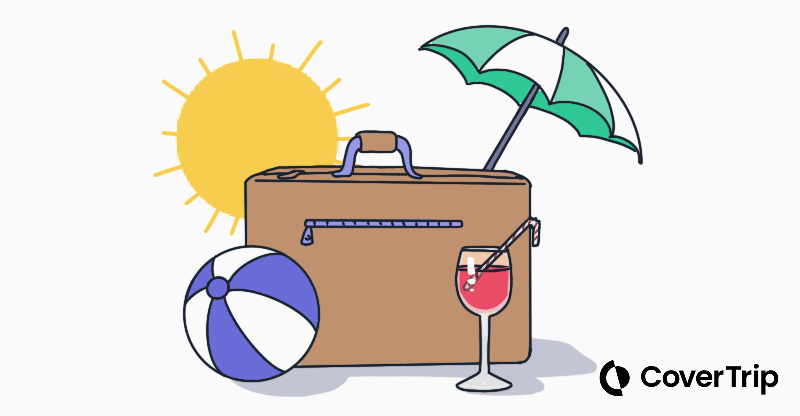Ultimate guide to productive and secure work travel
21 April 2024
The combination of work and travel isn’t a new idea by any means—experienced travelers and digital nomads have been blogging about how to do it for years.
The ability to actually do it, however, got unlocked during the pandemic, when many people faced situations they had no experience in:
- Parents had to work at home while also helping children manage school online
- College students could not be on campus but still needed to take classes
- Singles and couples could work from places where the rent was cheaper
Thanks to the continuation (for many people) of hybrid work options, it’s still a lot easier to mix work with personal travel. In fact, most business travelers squeeze in some kind of personal break on work trips, and full-time digital workers often put in a few hours at the office on vacation.
To make the most of this messiness, you can develop your own personal method of combining personal and professional travel.
Here’s how to do it.

1. Assess your personal situation
Before you stuff your backpack and lock your door, carefully assess your personal situation:
- Housing – If you own a home, can you comfortably rent it out or safely close it up while you travel? If you rent, can you end your lease and store your personal items?
- Relationships – If you’re in a committed relationship, is your partner on board? If you have responsibilities for elderly parents or family, is someone else able to step in while you travel?
- Employment – Are you an established part of your organization or just getting started? If you haven’t established yourself, the “out of sight, out of mind” trap can be hard avoid.
- Financial – Do you have a steady income and investments suitable for your age? Alternatively, do you have a pile of debt?
Everyone has to sacrifice at some point in life to save and invest; doing so earlier is better. Most digital nomads burn out in a few years because their long-term finances suffer, and catching up can be hard.
Bottom line: Take the time to carefully assess your personal situation before you pull the plug!
2. Start slow
There are many ways to combine work and travel, including:
- Trading houses with someone you know in another part of the US or elsewhere in the world.
- Joining an organization that arranges pet, house, or pet and house sitting and try living in different places in the US and internationally.
- To ease into living like a local, extend your business trips a little longer, find a local apartment, and work there for a month or two. Take cheap weekend trips to explore.
- If you have an established work record and employment, and you missed the chance to do a gap year, consider an adult gap year.
You may even try a combination of the above. Doing these kinds of options for a couple of years may even satisfy the urge to be a digital nomad—or set it on fire.
Bottom line: Not all travel and work options involve selling everything you own.
3. Get your tech set up
If you live in Melbourne and your organization’s IT office is in Baltimore, you may need to provide your own IT support. Managing your workday and keeping your job means getting the tech set up right immediately.
- Consider internet speed. Don’t assume that because the apartment is in a nice neighborhood, the internet is fast. Nothing can kill your workday (or your reputation back in the office) faster than lagging Wi-Fi. Ask the landlord about the speed, and consider researching a nearby co-working space as a backup.
- Set up your workspace. Working long hours requires a dedicated workspace, especially if you’re not working your normal hours. Most accommodations sites now let you filter on ‘dedicated workspace,’ and paging through the listing’s photos can help. Carefully examine what you need to be comfortable. For example, are you OK with working at a kitchen table sitting on a square-backed chair?
If you have a company that’s open to remote work farther afield, start conversations with the IT team early, so you know the requirements for laptop security, how to use a VPN, etc.
Pro tip: Some companies like Remote Year help you find accommodations and co-working space to take some of the planning lift off your shoulders.
Bottom line: Make certain you know how to support your tech needs while you work and travel.
4. Pick a suitable timezone
If you’re always asleep when the rest of your team is awake and collaborating, you’re not going to be successful as a remote worker.
For some jobs, like freelancing positions where you don’t have to be on calls, and it’s up to you to turn in the work on time, you can take advantage of the time difference by completing your work alone.
In the quiet. Where you can think.
For other jobs, working hours are working hours period. Lucky for you, there is a lot to explore in adjacent time zones, continent-by-continent. For the Europhiles among you, staying up late and working East Coast hours isn’t a bad gig. For those closer to the western coast of the US, there’s a lot of exploring to do north and south.
Bottom line: Pick a time zone that works with your job requirements and suits your work style.
5. Legalities
A visa is an endorsement on your passport that says you are allowed to enter, leave, or stay for a specified period in a country. Many countries limit how long a traveler can stay without applying for a visa, but since the pandemic, more countries are opening up their borders to full-time US workers without needing to apply for a visa.
This gives workers a lot more flexibility.
The list of countries that offer US citizens the chance to work and stay for up to a year changes year-by-year so you’ll have to do some research.
A recent report listed the 7 most popular countries for US workers as:
- Portugal
- Spain
- United Kingdom
- United Arab Emirates
- Canada
- Germany
- France
That doesn’t mean other countries aren’t great places to combine work and travel – these just happen to rank high for workers moving abroad right now.
Bottom line: Do your research to understand what visa will be required to work where you want.
6. Review the cost of living
Here’s where things start getting real. If you don’t already have a budget, it’s time to hunker down and make one. Document every expense you have for three full months.
Next, research the cost of living where you want to go. Match the expenses you have, including rent, utilities, groceries, haircuts, etc. to what it will cost to live elsewhere. Create a side-by-side comparison so you know whether you’ll be spending more or less while you combine work and travel.
The US is, by and large, a relatively expensive place to live. If saving money while you work and travel is important to you, it’s entirely possible, but you’ll only be sure if you do the work.
When you’re traveling, it can be hard to stay within a budget because everything is new, and you may want to buy things to take home or have experiences that you can’t afford at home. If you plan for it, you can make it work.
Bottom line: Be sure you know what to expect while you travel and work and stick to a budget!
7. Protect yourself
You could probably guess this was coming, and it’s important. If you are traveling on business with your organization, the time you are ‘on business’ is probably covered with some level of travel medical insurance. If not, you’ll need to protect yourself.
If you are extending your trip to combine work and travel, you’ll want to have medical protection at the very least. In fact, many countries now require travelers staying with extended work visas to have it.
Related topics
Damian Tysdal is the founder of CoverTrip, and is a licensed agent for travel insurance (MA 1883287). He believes travel insurance should be easier to understand, and started the first travel insurance blog in 2006.
